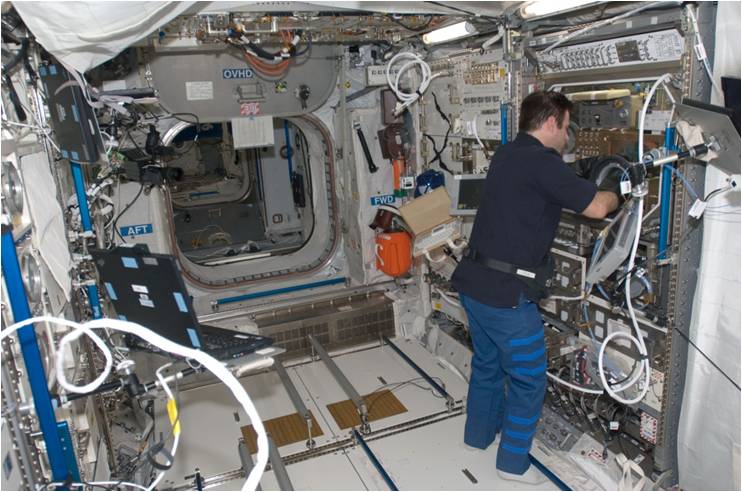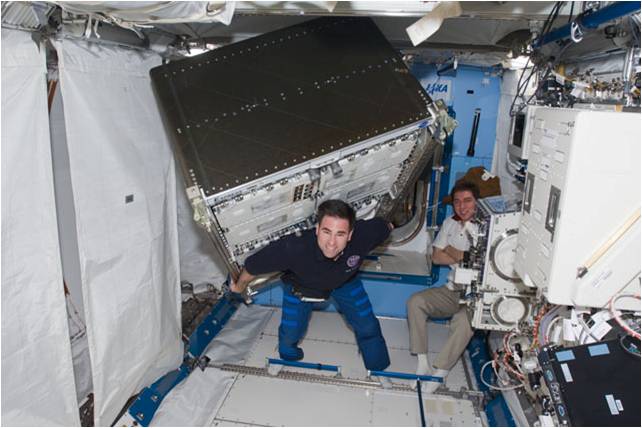In today’s A Lab Aloft, guest blogger Liz Warren, Ph.D., explains the flexibility in science capability on the International Space Station, thanks to the modular design of the research racks aboard the orbiting laboratory.
People are often shocked when they learn that the International Space Station is as large as a football field. They are also surprised to know that the interior volume is 32,333 cubic feet; that’s about the size of a five-bedroom house. Even though that is a very large volume, it pays to use ‘space’ smartly in space.
In order to be most efficient with the interior volume of the space station, the orbiting laboratory contains modular science facilities, usable by multiple investigators and experiment types. In fact, some of the facilities aboard the station are engineered for easy modification to meet the needs of different users. These ‘shared’ facilities enable efficient research utilization time aboard the station. Making facilities modular also allows for upgrades so that the space station stays on the cutting edge of science.

NASA astronaut Greg Chamitoff, Expedition 17 flight engineer, works with an experiment within the Microgravity Sciences Glovebox. (NASA)
Inside the Destiny, Kibo and Columbus laboratories, the walls, ceilings and floors are lined with science “rack” facilities. These racks, each similar in size to a big refrigerator (about 79.3 in. high, 41.3 in. wide, and 33.8 in. deep), are curved in the rear so that they fit almost flush against the inside surface of the cylindrical space station laboratory modules. The racks themselves are modular for easy relocation within the station as needed.
Some racks are built for housing several small-sized investigations. These EXPRESS racks provide power, air and water cooling, data and exhaust, command and control for up to a dozen different investigations. EXPRESS stands for Expedite the Processing of Experiments to the Space Station, reflecting the fact that this system was developed specifically to maximize the space station’s research capabilities.

NASA astronaut Greg Chamitoff, Expedition 17 flight engineer, works in the Kibo laboratory to move an EXPRESS rack during a relocation task. (NASA)
Other racks are specialized for specific disciplines such as combustion, fluids, materials, human research and Earth observation. There is also a glovebox that is suitable for handling and containing hazardous materials and several freezers to preserve science samples.
As a National Laboratory, the station science facilities built by NASA are available on a time-shared basis to other U.S. government agencies and private entities, such as commercial companies and universities, to pursue their own mission-driven research and applications. Shared use of international capabilities can also be arranged between NASA and the International Space Station partner agencies. Scientists that find they need a facility for their experiment that does not currently exist in orbit can work with their sponsoring organization to develop new hardware, which NASA will launch without cost to the scientist.
To highlight the capabilities of some of the space station’s science racks, Space Center Houston, the visitor center at NASA’s Johnson Space Center, enlisted help from the International Space Station Program and Space City Films of Houston to produce a unique video display for an updated space station exhibit. The exhibit is designed to educate and excite visitors about the accomplishments and importance the station plays in our continued human presence in space and the research conducted there.
The International Space Station has a variety of multidisciplinary laboratory facilities and equipment available for scientists to use. The video here highlights the capabilities of select facilities. (NASA/Space Center Houston)
The video display is actually a large wall, onto which the video projects from the back for a vibrant, life-sized, interactive experience!
I assisted in the production of this video for visitors to Space Center Houston to enjoy, providing images, video and scientific content. Viewing the finished product for the first time on a recent visit was fulfilling, but I know there is more work to be done to communicate the value of space station research.
The International Space Station is a premier, world-class laboratory in low-Earth orbit that promises to yield insights, science and technologies, the likes of which we have only begun to comprehend. With the capabilities of our research racks and facilities, investigators can use microgravity to unlock fundamentals of combustion, fluids, physiology and more to improve life on Earth in addition to supporting future space exploration.

Liz Warren, Ph.D., communications coordinator for the International Space Station Program Science Office. (NASA)

2 thoughts on “Smart Use of Science Space in Space”
Comments are closed.